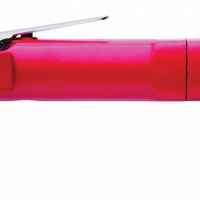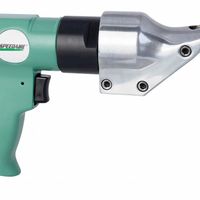Call +(254) 703 030 000 / 751 483 999 / 721 704 777
- Home
- Pneumatics
- Pneumatic Tools
- Air Powered Shears Nibblers
.....Read More
Frequently Asked Questions
What are the main differences between air-powered shears and nibblers?
Air-powered shears and nibblers are both pneumatic tools used for cutting sheet metal, but they have distinct differences in their operation and applications.
1. **Cutting Mechanism**:
- **Air-Powered Shears**: These tools use a scissor-like action to cut through metal. They have two blades, one fixed and one moving, that shear the metal as they close. This results in straight, clean cuts with minimal distortion.
- **Nibblers**: Nibblers cut by punching out small bits of metal, creating a series of tiny, overlapping cuts. This allows for more intricate and curved cuts but can leave a rougher edge compared to shears.
2. **Cutting Path**:
- **Air-Powered Shears**: Best suited for straight cuts or gentle curves. They are ideal for long, continuous cuts and produce minimal waste.
- **Nibblers**: Capable of cutting tight curves and intricate shapes. They are more versatile for complex patterns but generate more waste in the form of small metal chips.
3. **Material Distortion**:
- **Air-Powered Shears**: Tend to cause less distortion to the material, making them suitable for applications where maintaining the integrity of the metal is crucial.
- **Nibblers**: Can cause more distortion due to the punching action, which may not be ideal for precision work requiring a smooth finish.
4. **Speed and Efficiency**:
- **Air-Powered Shears**: Generally faster for straight cuts and can handle thicker materials more efficiently.
- **Nibblers**: Slower for straight cuts but excel in maneuverability for complex shapes.
5. **Applications**:
- **Air-Powered Shears**: Used in automotive, HVAC, and construction industries for tasks requiring straight cuts.
- **Nibblers**: Preferred for custom metalwork, artistic projects, and any application requiring detailed cutting.
How do air-powered shears work?
Air-powered shears, also known as pneumatic shears, operate using compressed air to perform cutting tasks. These tools are commonly used in industrial and manufacturing settings for cutting sheet metal, plastic, and other materials. The operation begins with an air compressor that generates and stores compressed air. This air is delivered through a hose to the shears.
Inside the shears, the compressed air enters a cylinder where it pushes against a piston. The movement of the piston is converted into mechanical motion, which drives the cutting blades. The blades are typically made of hardened steel to ensure durability and precision. As the piston moves, it causes one blade to move against a stationary blade, creating a scissor-like action that cuts through the material.
The operator controls the shears using a trigger or lever, which regulates the flow of air into the cylinder. This control allows for precise cutting and can be adjusted for different materials and thicknesses. The speed and force of the cutting action can be modified by adjusting the air pressure, providing versatility for various applications.
Air-powered shears are favored for their efficiency, as they offer continuous operation without the need for frequent recharging or battery replacement. They are also lighter and more maneuverable compared to electric shears, reducing operator fatigue. Additionally, they produce less heat and noise, making them suitable for prolonged use in industrial environments.
How do air-powered nibblers work?
Air-powered nibblers are pneumatic tools used for cutting sheet metal and other materials with precision and ease. They operate using compressed air, which powers a piston mechanism inside the tool. When the trigger is pressed, compressed air is directed into the tool, causing the piston to move rapidly back and forth. This reciprocating motion drives a punch or die that cuts through the material.
The cutting action of a nibbler is achieved through a small, fast-moving punch that shears away small pieces of the material, creating a clean, precise cut. The punch moves in a vertical motion against a stationary die, which supports the material being cut. As the punch moves up and down, it nibbles away small sections of the material, allowing for intricate cuts and curves without distorting the surrounding area.
Air-powered nibblers are particularly useful for cutting complex shapes and patterns in sheet metal, as they can maneuver easily around curves and corners. They are commonly used in automotive, construction, and metalworking industries for tasks such as cutting out panels, creating custom shapes, and trimming excess material.
The advantages of air-powered nibblers include their ability to cut without producing heat, which minimizes the risk of warping the material. They also produce minimal noise and vibration compared to other cutting tools. Additionally, they generate less waste, as the nibbled material is removed in small chips rather than large offcuts.
Overall, air-powered nibblers are efficient, versatile tools that provide precise cutting capabilities for a variety of materials and applications.
What are the advantages of using air-powered shears?
Air-powered shears, also known as pneumatic shears, offer several advantages:
1. **Efficiency and Speed**: Air-powered shears provide rapid cutting action, significantly increasing productivity compared to manual shears. They can handle repetitive tasks with consistent performance, reducing the time required for cutting operations.
2. **Reduced Operator Fatigue**: The pneumatic mechanism reduces the physical effort needed from the operator, minimizing fatigue and the risk of repetitive strain injuries. This is particularly beneficial in industrial settings where prolonged use is common.
3. **Precision and Control**: These shears offer precise control over cutting, allowing for clean and accurate cuts. The consistent power delivery ensures uniform results, which is crucial for maintaining quality in manufacturing processes.
4. **Versatility**: Air-powered shears can cut through a variety of materials, including metal, plastic, and fabric, making them suitable for diverse applications across different industries such as automotive, construction, and textiles.
5. **Durability and Low Maintenance**: Pneumatic tools generally have fewer moving parts than electric tools, leading to less wear and tear. This results in longer tool life and reduced maintenance costs, as they are less prone to mechanical failure.
6. **Safety**: Air-powered shears are often considered safer than electric shears because they do not produce sparks, reducing the risk of fire in environments with flammable materials. Additionally, they are less likely to overheat.
7. **Environmentally Friendly**: Since they do not rely on electricity, air-powered shears can be more environmentally friendly, especially when the compressed air is generated using renewable energy sources.
8. **Cost-Effectiveness**: Over time, the durability and low maintenance requirements of air-powered shears can lead to cost savings, making them a cost-effective choice for businesses looking to optimize their operations.
What are the advantages of using air-powered nibblers?
Air-powered nibblers offer several advantages, making them a preferred choice for cutting sheet metal and other materials:
1. **Precision Cutting**: Air-powered nibblers provide clean, precise cuts without distorting the material. This is particularly beneficial for intricate shapes and patterns, ensuring high-quality finishes.
2. **Versatility**: They can cut through various materials, including steel, aluminum, and plastic, making them suitable for diverse applications in automotive, construction, and manufacturing industries.
3. **Ease of Use**: These tools are generally lightweight and ergonomically designed, reducing user fatigue and allowing for extended use. Their compact size also enables access to tight spaces.
4. **Speed and Efficiency**: Air-powered nibblers operate at high speeds, allowing for quick cutting processes. This efficiency can significantly reduce project time, increasing productivity.
5. **Minimal Heat Generation**: Unlike some cutting tools, nibblers generate minimal heat, reducing the risk of warping or damaging heat-sensitive materials.
6. **Reduced Material Waste**: The cutting action of nibblers produces small, manageable waste pieces, minimizing material wastage and cleanup time.
7. **Durability and Longevity**: Air-powered tools generally have fewer moving parts than electric tools, leading to less wear and tear and a longer lifespan.
8. **Safety**: They are safer to use as they produce fewer sparks and less noise compared to other cutting tools, reducing the risk of accidents and hearing damage.
9. **Cost-Effectiveness**: While the initial investment might be higher, the durability and efficiency of air-powered nibblers can lead to cost savings over time due to reduced maintenance and replacement needs.
10. **Environmentally Friendly**: As they do not rely on electricity, air-powered nibblers can be more environmentally friendly, especially when used with renewable energy sources for air compression.
How do I choose between air-powered shears and nibblers for my project?
To choose between air-powered shears and nibblers, consider the following factors:
1. **Material Type and Thickness**:
- **Shears**: Best for cutting straight lines or large curves in sheet metal. They work well on materials like aluminum, mild steel, and stainless steel, typically up to 14-gauge thickness.
- **Nibblers**: Ideal for intricate cuts, tight curves, and complex shapes. They can handle thicker materials, often up to 10-gauge, depending on the model.
2. **Cutting Speed and Precision**:
- **Shears**: Faster for long, straight cuts but may distort the metal slightly. They produce minimal waste.
- **Nibblers**: Slower but offer greater precision for detailed work. They create small metal chips, which can be messy.
3. **Edge Quality**:
- **Shears**: May leave a slightly rough edge that might require deburring.
- **Nibblers**: Provide a cleaner edge with less distortion, reducing the need for additional finishing.
4. **Project Requirements**:
- **Shears**: Suitable for projects requiring quick, straight cuts, like roofing or HVAC ductwork.
- **Nibblers**: Better for custom fabrication, automotive work, or any project needing detailed cuts.
5. **Tool Handling and Accessibility**:
- **Shears**: Generally lighter and easier to handle for extended periods.
- **Nibblers**: Bulkier but offer more control for intricate work.
6. **Cost and Maintenance**:
- **Shears**: Typically less expensive and require less maintenance.
- **Nibblers**: Higher initial cost and maintenance due to more complex mechanisms.
7. **Noise and Vibration**:
- **Shears**: Quieter with less vibration.
- **Nibblers**: Noisier and may cause more vibration, requiring ear protection.
Evaluate these factors based on your specific project needs to make an informed decision.
What maintenance is required for air-powered shears and nibblers?
Maintenance for air-powered shears and nibblers involves several key steps to ensure optimal performance and longevity:
1. **Regular Cleaning**: After each use, clean the tool to remove metal shavings, dust, and debris. Use compressed air to blow out particles from hard-to-reach areas.
2. **Lubrication**: Apply a few drops of pneumatic tool oil into the air inlet before and after use to keep internal components lubricated. This prevents rust and reduces friction.
3. **Inspect and Replace Blades**: Regularly check the condition of the blades. Replace them if they are dull, chipped, or damaged to ensure clean cuts and prevent strain on the motor.
4. **Check Air Supply**: Ensure the air compressor provides the correct pressure and volume as specified by the manufacturer. Use a filter-regulator-lubricator (FRL) system to maintain clean, dry, and lubricated air.
5. **Tighten Fasteners**: Periodically inspect and tighten any loose screws, nuts, or bolts to prevent parts from becoming misaligned or detached during operation.
6. **Inspect Hoses and Connections**: Check air hoses and connections for leaks, cracks, or wear. Replace any damaged components to maintain efficient air flow.
7. **Test Performance**: Regularly test the tool’s performance. If it’s not cutting efficiently, it may need servicing or parts replacement.
8. **Storage**: Store the tool in a clean, dry place to prevent moisture damage. Use protective covers or cases to shield it from dust and impact.
9. **Follow Manufacturer’s Guidelines**: Adhere to the maintenance schedule and procedures outlined in the user manual for specific guidance tailored to your model.
10. **Professional Servicing**: Periodically have the tool serviced by a professional to address any complex issues and ensure all components are in good working order.

